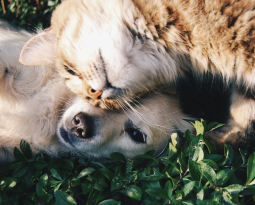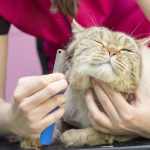While cats are not as susceptible to eye problems as dogs, they can and do develop a few certain conditions quite easily. Here at Acoma Animal Clinic in Tucson, we care about your kitty’s eye health and are happy to help you with any concerns you may have. If you notice your cat is squinting, if they’re eye is watering or producing discharge, please contact us or your primary vet immediately.
If you want to look more into eye problems, here is a list of common cat eye diseases complied by Acoma Animal Clinic in Tucson.
Conjunctivitis
Conjunctivitis is common for most mammals. Otherwise known as pink eye, it occurs when the membrane outside of the eye and inside of the eyelid becomes inflamed. In humans, it creates a pink-ish/red hue to your eye and is highly contagious. Fear not though, if your cat catches it, can only be transferred to other cats and not humans.
It’s usually caused by a virus of bacterial infection that led to an upper respiratory illness. Because the whites of cats’ eyes are not normally visible, you’ll need to watch out for runiness. You can expect to see clear, gray, yellow, green, or dark reddish eye discharge pooling under their eye and in their eye crease. You may notice swelling around their eyes too.
Also be sure to look out for signs of respiratory distress (a cold or fever), like sneezing and a dripping nose.
Thankfully treating conjunctivitis is simple; a vet needs to prescribe topical antibiotics or ointment that is applied directly to your cat’s eye. They’ll show you how to use it. If you need a refresher, hold your cat’s scruff in one hand. Put the ointment or drops in your other hand and gently turn their face and open their infected eye with your thumb. Apply the medication as directed by your vet. We recommend holding your cat’s scruff for a little while after applying the medication to ensure they don’t shake it or paw it out of their eye too quickly.
Conjunctivitis can also be caused by FHV-1, which is the feline herpes virus. Don’t panic if your vet does believe this is the cause — feline herpes is very different from the human strain. It is, essentially, just viral inflammation.
Eye Irritation
Have you ever had red, itchy, watery, or just generally prickly eyes? For humans, that’s normally caused by allergies. Cats are another story. Their eyes can get irritated the same way ours do, but it’s generally caused by irritants in the air (like smoke, perfume, cleaning supplies, and dust) or injury.
Pretty much anything that can get in your eye that causes irritation, can get in their eyes too. You’re going to want to watch out for your cat squinting, rubbing at their eye, or redness and small amounts of discharge.
Treating it is usually easy — if it’s debris, it will naturally get dislodged over time. If your cat allows it, you can try rinsing out her eye with an eye-wash solution.
If that doesn’t help, it could be caused by something a little more serious. Take your cat to the vet so they can do a full eye exam to determine if it’s an injury or an illness that’s causing the irritation.
Corneal Ulcers
An ulcer is an open sore. So a corneal ulcer is an open sore on your cat’s eyes. It’s one of the more potential serious cat eye diseases, so it’s best to take your kitty to the vet right away.
They can be easy to spot — they might cause a milky or cloudy spot to appear on your pet’s eye. Your cat will also be irritated by it, so they will probably be squinting and rubbing it. It may also be red and produce discharge as well.
Ulcers aren’t terribly common in regular house cats, but can develop if your cat has an eye injury, chronic dry eye, or abnormalities in their eye or eye socket.
Corneal Ulcers should always be treated by a vet. Mild ones might require an antibiotic ointment or drops to help relieve any pain or discomfort your cat may be feeling. More severe ulcers may require surgery.
If left untreated, corneal ulcers can lead to blindness and facial disfigurement.
Glaucoma
Glaucoma in cats is similar to the disease in humans. It is high-pressure in the eye, but in cat’s, it’s usually caused by a buildup of fluids. It is a serious condition and should be treated by a vet right away. It can lead to permanent blindness and facial disfigurement.
It’s caused when your cat’s eye can’t release fluids naturally. This means anything like a disfigured eye or eye socket, eye infection, inflammation, trauma, or a tumor could cause it.
If you believe your cat has glaucoma, take them to the vet immediately. The sooner a vet can drain the fluid, the better chance they have of saving your cat’s vision and eye.







